BlackBerry Storm Review
BlackBerry Storm
The Storm is the first ever touchscreen BlackBerry, but was it worth the wait?
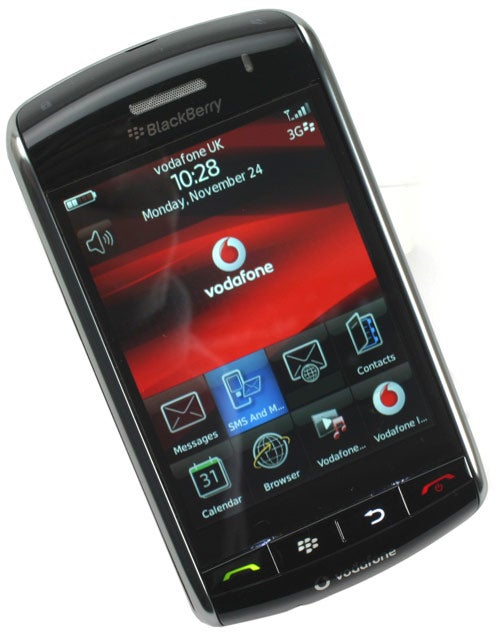
Verdict
For the past 18 months, we’ve seen a multitude of manufacturers trying to create a touchscreen handset that can compete with the iPhone, most of which don’t come close to the design or usability of Apple’s device. But what I never imagined was that the best alternative to an iPhone would be a BlackBerry.
The Storm is probably the most anticipated BlackBerry ever, not just because of the obvious comparisons with the iPhone, but also because it’s the first touchscreen BlackBerry, which in itself is quite a milestone for RIM. The question is whether RIM can create a touchscreen device that’s as attractive to the general consumer as it is to the corporate, mobile email junkie.
The answer to that question is quite complicated though. I do like the BlackBerry Storm, I like it a lot. But I also need to point out that it’s not perfect, not that I’ve ever found a handset that is. But in this context, there are some issues with the Storm that simply shouldn’t be there, and end up taking some of the shine off an otherwise excellent device, much as with the original iPhone in fact. But I’m getting a little ahead of myself. Let’s cover the basics first.
The Storm looks great, finished in a mix of brushed metal combined with silver and black plastic. The edges have a rubberised coating that makes it really easy to get a good grip on the device, unlike the iPhone – especially the first generation model. The Storm is ever so slightly shorter than the iPhone, although it looks significantly shorted due to its tapered edges. It is, however, noticeably thicker, although this doesn’t make it uncomfortable to hold, quite the contrary in fact. 
The Storm is heavier than the iPhone at 157g compared to 143g for the original iPhone and 137g for the iPhone 3G. You can feel the extra weight in your hand, but again it’s not something that bothered me. With dimensions of 113 x 62 x 14mm (LxWxD) it’s clear that this isn’t a small phone, but it’s no bigger than any other decent touchscreen device.
Obviously the front of the Storm is dominated by the touchscreen, but I’ll cover that later on. Below the touchscreen are four buttons – Call, End, Back and Menu. The Menu button is key here, since it is the traditional BlackBerry Menu button, which will bring up a list of options that are applicable to the current screen or application. There are two more buttons on the top edge – Mute and Lock. The latter will lock the handset and disable all inputs until the Lock button is pressed again.
Along the right edge you’ll find a 3.5mm headphone socket (Hurrah!), volume controls and a dedicated button for the 3.2-megapixel camera. On the left is the usual BlackBerry voicedial button along with a micro-USB connector. The latter is a major annoyance – I just can’t understand why RIM didn’t use standard mini-USB for power/PC connection. Pretty much everyone has multiple mini-USB cables and chargers knocking about, which means that you never have to worry about having the correct cable with you to charge/sync your device. It’s not like a mini-USB connector wouldn’t have fit either. Anything that makes me have to carry more cables when I travel is not good, simple as that.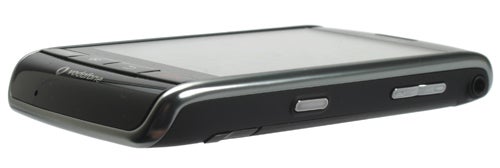
It’s the screen that’s the real star of this BlackBerry, and rightfully so. The 3.25in display is slightly smaller than the screen on the iPhone, which measures 3.5in. However, the Storm’s screen sports a slightly higher resolution at 480 x 360, as opposed to the iPhone’s 480 x 320, which results in a slightly sharper image. Of course the Storm still can’t match the ridiculous pixel density of the BlackBerry Bold, which squeezes a 480 x 320 resolution into a 2.5in screen. 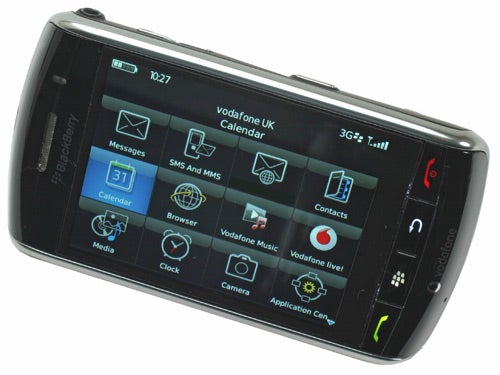
The screen really does look superb, although, as with the Bold, the Vodafone red background really helps show it off to best effect. Colours are very vivid, while the overall brightness is impressive, although not quite to the levels of the Bold. The only tangible downside to the screen is the very noticeable light bleed from the top and bottom. This is particularly evident when you’re using the Storm in a darkened room, despite the fact that the device automatically dims the display in accordance to ambient lighting.
But it’s not the way the screen looks that’s so important, it’s how you interact with it, because although this is a multi-touch screen, it also clicks. What I mean is that you physically press the screen inwards to select items, in the same way that you would with a traditional button. This brings with it the advantage of being able to highlight or “hover” over links on a page without actually selecting them, thus ensuring that you have the right thing selected before actually clicking. This is particularly useful on busy web pages where several links are close together, and can save you a lot of page reloads or zooming. 
The clicking screen is also used for typing on the Storm, and here I think that it works beautifully. Interestingly, Andy found it very hard to get to grips with the clicking screen, citing it as cumbersome compared to his iPhone. As a long term iPhone user myself I will admit that Apple’s device still has the best mobile keyboard, but the Storm definitely comes in at a close second. I’ll admit that the click screen takes a bit of getting used to, but once you’ve got your head around physically clicking, you’ll be surprised at how quickly you can knock out paragraphs.
Talking of typing, the Storm offers two forms of text input. With the device held in portrait mode, you’re presented with BlackBerry’s excellent SureType system, which is a bit like T9 on steroids. SureType was first seen on the BlackBerry 7100, and has just got better over the years; so much so that I can type pretty much flawlessly at speed, using it. However, if you simply can’t get on with SureType, you can switch to a landscape orientation, where you’ll be greeted with a full QWERTY keyboard – and even Andy had to admit that typing on the Storm using this method was pretty good. 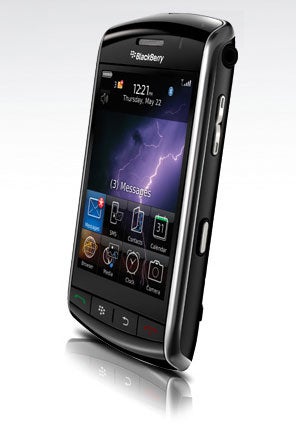
However, the click screen isn’t perfect, and you need to be very careful where you’re clicking. When I first started using the Storm I found that whenever I tried to click an option or link, I ended up actually clicking the option directly below it. Basically, as I was pressing I was rolling my thumb downwards and clicking the wrong selection. Initially I found this incredibly frustrating, but I eventually started to click just above the link, which resulted in the right option being selected. I now do this without thinking when using the Storm, so if you encounter the same issue, persevere and you’ll find that you naturally overcome the problem. I dare say that if I wasn’t so used to using an iPhone I may not have encountered this issue in the first place.
Putting the click screen to one side, this is also a multi-touch screen, which means that it has a few neat tricks up its sleeve – one being very simple copy and paste functionality. If you want to copy a chunk of text from an email, to say, an text message, you simply touch the screen at the beginning of the text and again at the end – the text will then be highlighted. Now you just press the Menu button and select the Copy option, then when you want to insert the text just press the Menu button again and select the Paste option. Take note Apple!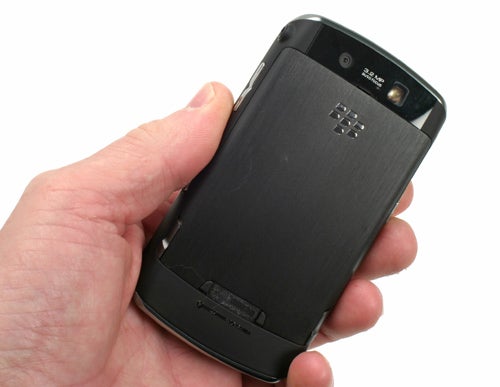
You can of course scroll through web pages and menus, but there’s no sense of inertia like there is on the iPhone. This makes the whole process seem somewhat stunted and frankly disappointing. That said, this is clearly a software issue, because if you fire up a specific application, like Vodafone’s music store, you can scroll through selections with a level of inertia that’s every bit as good as on the iPhone. Come on RIM, it can’t be that hard to inject a bit of inertia into the menus, or in fact the otherwise excellent browser.
Talking of the browser, it really is very good and has no problem rendering complex pages like TrustedReviews. Interestingly you can click to zoom into a page or double tap, iPhone style. Column mode is still there, and as useful as ever, forcing the text to fill the entire width of the screen at the largest possible font, for ease of reading. As already mentioned, the click screen really does save you a lot of accidental link selection, something that even the iPhone falls foul of quite frequently.
There’s a built-in GPS, which is pretty much par for the course these days. You have the option of using BlackBerry Maps or Vodafone Find and Go, but if you’ve got any sense you’ll do exactly what I did and download Google Maps the first chance you get. As with the Bold, Google Maps works very well and very fast. Strangely, the double tap doesn’t zoom in on Google Maps the way it does on web pages, and although the zoom in/out icons in the bottom left of the screen work well enough, they’re still no substitute for the pinching in/out method on the iPhone.
Since this is the first touchscreen BlackBerry it comes as no surprise that it’s also the most accomplished when it comes to media playback. The music player is very good indeed – OK, so it’s not quite as slick as the iPhone, which is basically an iPod touch, but it’s the best I’ve seen on a non-Apple phone. You get full screen album art, with basic playback controls along the bottom – the Mute button on the top of the device also doubles as a Play/Pause button, so it’s easy to stop playback without having to take the Storm out of your pocket. Hitting the Menu button brings up a plethora of useful options like Shuffle, Repeat and my personal favourite, Set As Ringtone. The Storm is also happy to stream its music to a Bluetooth receiver, which is handy since you get one of these in the box. The small, square receiver is nicely unobtrusive – it’s powered via its mini-USB port, and has a 3.5mm jack so you can connect it up to a pair of speakers or your hi-fi.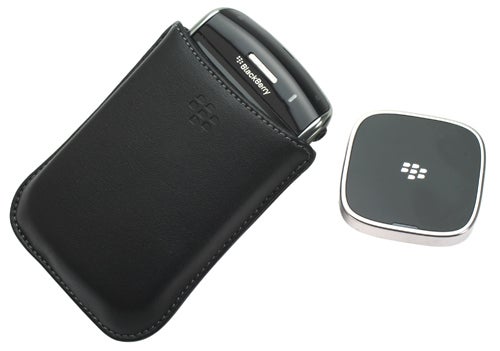
Video playback is also good, with the screen put to good use in landscape mode. Whether you think that a device this size is suitable for watching video is a personal thing, but if you’re happy with the iPhone or iPod touch, then you’ll be just as happy with the Storm. YouTube is also well integrated into the Storm, and if you’re the type that wastes many hours trawling YouTube, you’ll be able to make the most of any long journeys. The fast HSDPA data rate means that you really can stream video to the Storm anytime and anyplace. It’s also a blessing not to have to use iTunes to get media content on and off the Storm – my second biggest annoyance as an iPhone user is having to use iTunes, with the first being the appalling signal strength on my first generation unit.
The 3.2-Megapixel can produce surprisingly good images, but getting the best out of it is very hard. Although the camera has a solid auto-focus system, it also suffers from the worst case of shutter lag I’ve seen in years. It takes four seconds from the point that you press the button, to the point that the shutter sound is heard and the image is displayed. Given, it appears that the image is captured early in the four seconds of “black screen”, but it’s still hard to gauge exactly when the shot is taken. And shooting anything that’s moving is pretty much impossible.
Unlike the iPhone, the Storm does feature MMS and video recording, but there’s no video calling, since the device doesn’t have a front mounted camera. Of course most iPhone users will insist that they don’t need MMS and video recording – as always, it comes down to personal need and preference.
But as with all BlackBerry devices, it’s the mobile email integration that’s a, if not the key feature. RIM has been doing push email for so long now, that the BlackBerry is pretty much synonymous with email in your pocket. The Storm is just as good as any other BlackBerry at accessing your email, and in some ways better. The obvious advantage is the big screen, that makes it easy to read longer emails. But RIM has also integrated the Storm’s multi-touch support into the email client, so when you’ve finished reading one email, you can simply swipe the screen to switch to the next one. Obviously the Storm has full Exchange support through the BlackBerry Enterprise Solution, but if you don’t have corporate Exchange setup, it’s simple to add multiple standard email accounts to the Storm. 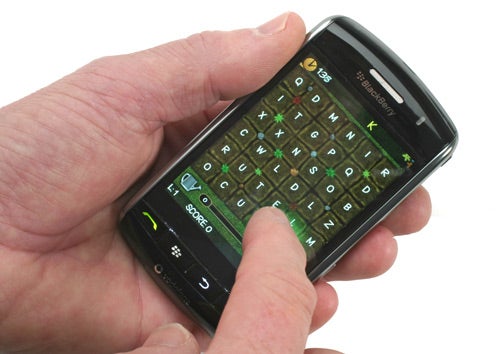
The Documents To Go suite comes pre-installed on the Storm, but you can’t create new documents, you can only view and edit existing documents. You’ll need to buy the Premium version if you want to create new documents. However, all you really need to do is copy template documents to the Storm, then just edit them and save them under a different name whenever you need to create a new document.
Hardware wise, this is a quad-band handset so it should work pretty much anywhere in the world, including difficult locations like Japan. From a data perspective the Storm can handle full 7.2mbps HSDPA, along with UMTS, Edge and GPRS, so you should be able to get at least some kind of data service no matter where you are. There’s 1GB of storage built into the Storm, but it does sport a microSD card slot, so you can expand that storage easily and cheaply – it only costs around £16 for an 8GB microSD card.
One of the strongest selling points of BlackBerry handsets has always been long battery life, but unfortunately this isn’t carried over into the Storm. RIM quotes 15 days standby time, but in reality the Storm gets nowhere near that. If you have any intention of actually using the Storm as a data device and a phone, you’re going to have to charge it every night. And even leaving the device purely on standby, without really interacting with it, I couldn’t get more than two or three days before the battery went dead. That said, I’m not one to bleat on about having to charge a phone every day, since I tend to charge my phone overnight as a matter of course, it’s simply not that much of a hardship. The annoyance comes when you have to go away for a few days and you’re hoping that you don’t have to take a phone charger with you – in the case of the Storm, take the charger with you.
The battery life isn’t the only disappointment either. The Storm has an accelerometer built into it, so the screen automatically switches orientation as you twist the device. And unlike the iPhone you can switch orientation no matter what you’re doing – so if you’d rather navigate the basic BlackBerry OS in landscape, you can. Unfortunately the accelerometer is temperamental to say the very least. Sometimes the orientation simply refuses to switch, while other times it switches when you don’t want it to.
There’s one other issue with the Storm, and that’s its lack of Wi-Fi. OK, I’ll admit that Vodafone’s HSDPA service is pretty damn good, but in the TrustedReviews offices for example, the best I could manage was GPRS, so I would have preferred for the Storm to switch to Wi-Fi for data while at the office. The lack of Wi-Fi is compounded if you plan on using your Storm abroad, where roaming data charges can be crippling – at least if you use a Wi-Fi hotspot you know exactly how much it’s costing you, but that option is off the menu with the Storm. 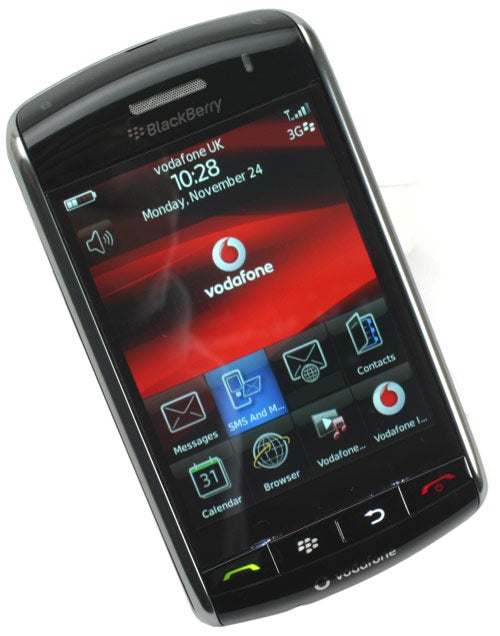
The Storm is available exclusively on Vodafone, which means that you get arguably the best HSDPA network in the UK. If you go for a £40 per month 18 month contract you can get the Storm for free and get unlimited email and texts, along with 600 minutes of calls. That’s a similar package to the £35 iPhone tariff, but of course you’re paying almost £100 for the handset on that tariff, so the Storm measures up pretty well.
Despite all the issues and niggles, as I’ve already mentioned, I really like the Storm. This is a very good handset, and probably the closest that RIM has ever come to a true crossover device. But the Storm is just a whisker away from being a truly great handset, and one that really could have given the iPhone a real run for its money. As it stands, if you lust after the usability of the iPhone but need the functionality of the BlackBerry email client, the Storm will make you a very happy bunny.
”’Verdict”’
RIM should be very proud of the BlackBerry Storm. Considering that this is the first touchscreen BlackBerry, it’s a surprisingly accomplished device, and one that’s often a joy to use. But there are issues with the Storm like the lack of Wi-Fi, temperamental accelerometer and disappointing battery life that take off some of the shine. Despite these problems, the Storm is still the closest real competitor to Apple’s iPhone seen to date. Couple that with the legendary BlackBerry email client and I can see the Storm doing very well indeed.
How we test phones
We test every mobile phone we review thoroughly. We use industry standard tests to compare features properly and we use the phone as our main device over the review period. We’ll always tell you what we find and we never, ever, accept money to review a product.
Trusted Score
Score in detail
-
Performance 8
-
Design 9
-
Value 9
-
Features 8
General
| Operating System | BlackBerry |
| Height (Millimeter) | 112.5mm |
| Width (Millimeter) | 62.2mm |
| Depth (Millimeter) | 14mm |
| Weight (Gram) | 155g |
| Available Colours | Black |
Display
| Screen Size (inches) (Inch) | 3.25in |
| Screen Resolution | 360x480 |
| Touchscreen | Yes |
Battery
| Talk Time (Minute) | 330m |
| Standby Time (Hour) | 360hr |
Storage
| Internal Storage (Gigabyte) | 1GB |
| Camera (Megapixel) | 3.15 Megapixel |
| Front Facing Camera (Megapixel) | No Megapixel |
| Camera Flash | LED |
Connectivity
| Bluetooth | Yes |
| WiFi | No |
| 3G/4G | Yes |
| 3.5mm Headphone Jack | Yes |
| Charging/Computer Connection | microUSB |
Processor and Internal Specs
| CPU | 528MHz |
Misc
| App Store | BlackBerry App World |
| GPS | Yes |

